
For this 14 of july 2022, French national holiday, here is the Clemenceau class carriers: Clemenceau and Foch were the first purpose-designed aircraft carriers in France since the Joffre class in 1938. They were somewhat inspired by the modernized Essex class, and became the only CATOBAR carriers in Europe in the late 1970s. They were decommissioned in 1997 and 2000, although Foch was sold to Brazil as Sao Paulo and served for another 17 years.
In short, the Clemenceau class were practically the only French carriers active for most of the cold war. France however had operated before they were completed the former British Dixmude (ex- HMS Bitter C3 converted escort vessel) until 1960, Arromanches (ex- HMS Colossus) in 1946-74, and Lafayette (ex-Langley) and Bois Belleau (Belleau Woods) both fast light carriers of the Independence class in 1950-63. They were replaced by FS Charles de Gaulle (R91) after a long study for a nuclear carrier class planned since 1982.
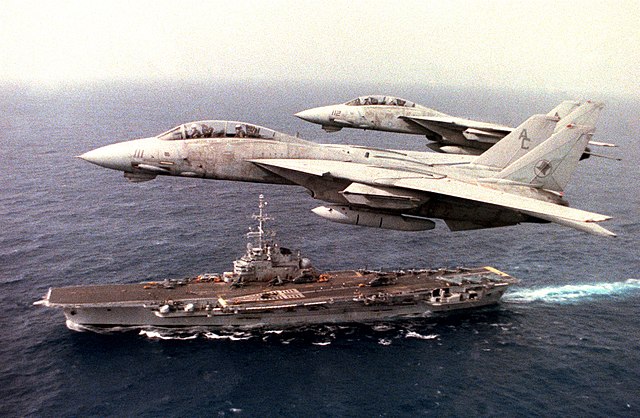
Grumman F-14A Tomcats from VF-14 (USS JF Kennedy) fly over FS Foch (R99) in the Carribean Sea 1 May 1990 during an exercize
Design development
PA 28, the early draft
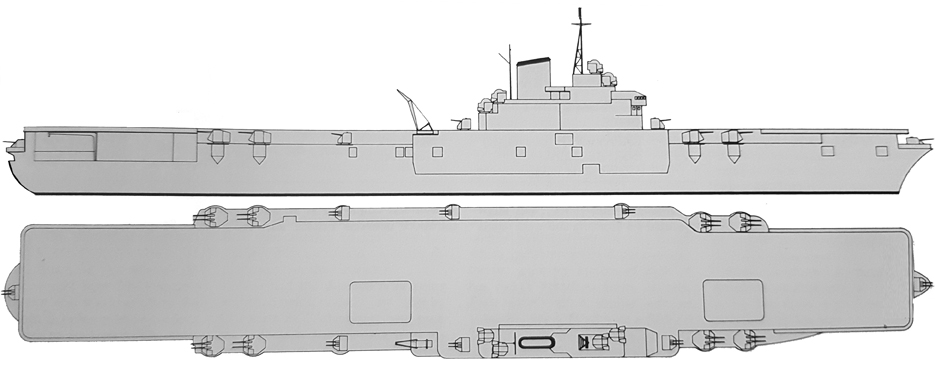
Since the old Béarn to the point of being deactivated, France in 1945 started studies for a replacement, in part based on studies already done for the purpose-built Joffre class. This led to a first design, called the PA28 Aircraft Carriers (1947). The initial “Clemenceau” was a secret project woekd on in occupied France, as an improvement over the late 1930s Joffre design.
It was planned to built it as soon as the war ended. By August 1947 the design was approved, construction ordered, to be laid down at Brest as “PA28”. Design-wise, it was in part inspired by British light carrier design. The straight flight deck was armoured, both hangars were offset to port, two lifts 15 x 10 m carried 12 tons installed forward and aft of the island and to stop planes, seven arrestor cables. Launches used two steam-driven catapults.
The propulsion system was basically twice the one used on the Mogador class large destroyers, for 105,000 hp and 32 knots. The AA rested on eight twin 100 mm turrets fore and aft, six twin 57 mm (So 24 in all) and 45 aicraft carried. As planned, a mix of Piston engines Fighters SNCASE SE 580 and Jets SNCAC NC1070. In 1949, after a change of minister, the design was revised and considered already outdated, while recent US upgrades planned on WW2 shown a new path more favourable for heavier jets. The PA28 was cancelled in 1950.
Specifications: 15,700/20,000 tons, 214/230 m oa x 25.4m/36 x x 6.5 m, 2 shaft Parsons turbines, Complement: 1800.
PA 54, a brand new 1953 design.
By the early 1950s, the French Navy had no less than four aircraft carriers in service, all dating back from the war: The most modern and larger was Arromanches, ex- British Colossus, followed by rather small vessels, the escort Dixmude (hms Biter) and two Independence class (Lafayette and Bois Belleau). All were fine for piston engine aircraft, but way too small to operated modern aircraft, jets in particular.
To ensure France remained independence in aicraft carrier construction two modern fleet carriers were planned, the first being about 35,000 tons each, comparable, but smaller than the Audacious-class carriers. Built from scratch would be the occasion of taking on the latest ideas in aircraft carrier design: They would be equipped at the onset with an angled flight deck, steam catapults and mirror landing aid now widespread in US and British carriers. They would operate a new generation of French designed jets as well.
The previous PA 28 being cancelled, the initial draft for the new carriers was prepared by the Naval General Staff in 1949. It asked for four aircraft carriers of 20,000 tons, delivered in two phases. After a meeting 22 August 1949, the Supreme Council of the Navy asked for six. On 15 July 1952 however amidst economic hardships, the French Navy looked for a total of up to five for the whole French Union that would not all be available to NATO.
According to RCM 12 after the Lisbon Conference of 1952, France was asked to have a carrier ready at NATO’s request on the first day, two on the 30th and three at 180, which implied laying down three keels in close order. However, plans changed gradually and by 1953 the Navy reorganized it’s strenght around just two tasks forces to cover all her needs, which implied only two aircraft carriers.
PA 54 was budgeted in 1953 but delayed until November 1955. She was in between named “Clemenceau” after PM Georges Clemenceau nicknamed the “tiger”, in charge from 1917. Next was PA 55 Foch, budgeted FY1955, and also delayed until February 1957. She was named after the WWI French entente generalissimo, Marshall Ferdinand Foch.
Detailed design
These were a class of multi-role aircraft carriers, in order to replace all WW2 era ships provided until then. They took everything that was appealing to the admirakty from the British and US models but in the end for their general appearance, they leaned more strongly to the latter. This was overall a small but effective design, like a mix od modernized Essex SCB-27C or even a Forrestal (also in construction at the time) but on a smaller scale for the latter. At the time, missile development was less advanced than in the UK or the US and thus, an all-gun armament was retained. The designers did not anticipated later additions making the ships top-heavy and requiring bulging the hull to solve stability issues.
The Clemenceau-class were conventional CATOBAR designs, launching standard jets through catapults. There was bi debate about the issue. There was a continuation of WW2 designs, years before any STOVL prototype was even in the works. Helicopters were also not a thing for power projection and thus a conventional park was though of from the beginning. At 22,000 standard tonnes and 32,780 max fully loaded, the two Clemenceau class were half the size of a Forrestal, and comlparable to WW2 Essex class, or the unbuilt Malta class. They measured 265 m (869 ft) overall at flight deck level, for a beam of 51.2 m (168 ft) and Draught of 8.6 m (28 ft).
Crew: Number of officers: 80, Number of petty officers: 500, Number of quartermasters and sailors: 800
Powerplant
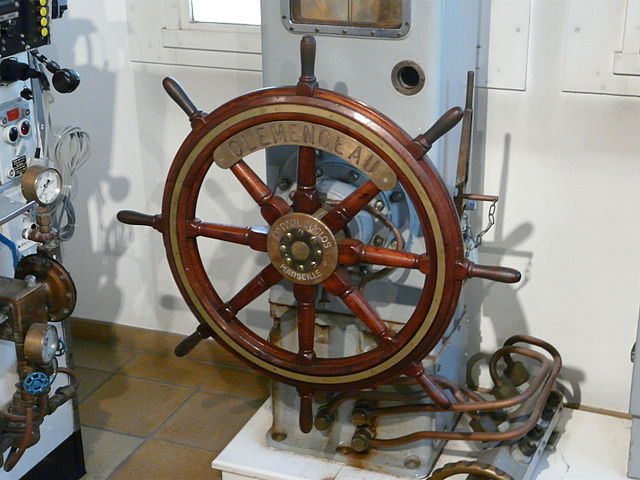
Rudder wheel aboard Clemenceau
Clemenceau’s (PA 54 class) powerplant was classic. At the time, it is not clear if the French Navy knew the US were working on nuclear powerplant for their carriers and submarines, but in France its development was just started and lack funding. Its adoption was out of question. The radical impulse in the French nuclear program, also carried out for propulsion, started in 1958 under the impulsion and unrelentless drive of De Gaulle. Therefore since 1954 it was envisioned a classic powerplant, taking example of the one planned for the Gascoigne class fast battleships. It consisted two sets of the latest Parsons geared steam turbines fed by 6 Indret boilers. It was quite remarkable for a ship of this size with a figure of 63,000shp per shaft only surpassed only by USN super carriers.
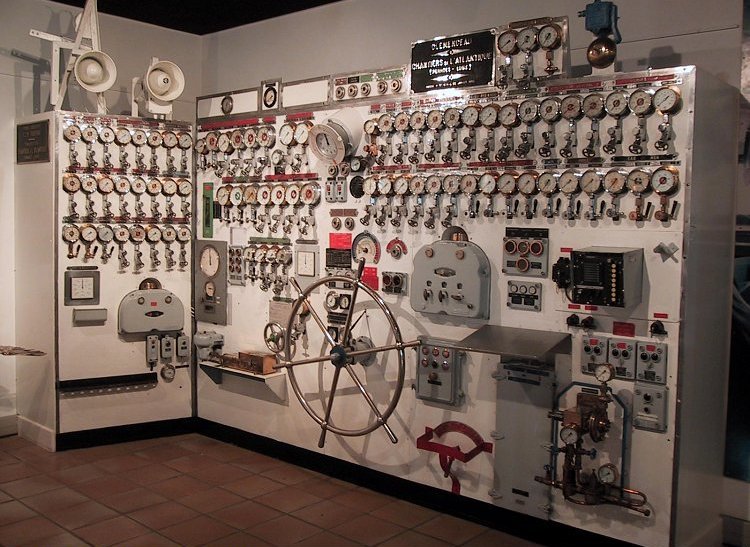
Engine control panel
After their 1978-1980 refit the PA 54 had the following:
-Four propeller shafts (diameter)
-Four RB geared steam turbines
-Six massive double-ended small tubes oil-fired with injectors, very high pressure boilers
-Grand total output 126,000 shp.
-Top Speed: 32 knots (59 km/h) (32.5-33 knots on trials)
-Range as planned: 7,500 miles/18 kts or 3 500 miles nautical @ 32 knots
-2 alternative diesel power unit (2000 KW)
-2 turbo-alternators (2000 KW)
As of note, the range was short, compared to larger USN carriers at around 10,000 nm, but it was fit for the Mediterranean and a good achievement for their size.
Protection
The passive protection consisted in some classic armour, with the following:
-Fully Armored flight deck 2-in (45 mm)
-Armored boxes above the machinery space: 2.5-in (50 mm)
-Box around the ammunition holds: 1-in (30 mm)
-Citadel: Sides, bulkheads and deck of the hangar: 2-in (51 mm) of reinforced plates.
Armament
For 1954 when they were first studied, missile development was in its infancy in France, and thus, guns were retained for thes carriers at the start. It comprised only a single type: The new French turret developed as a universal gun, eight 100mm in sponsons, two fore and aft on both sides, in sponsons. This classic configuration was coherent with British and US practices of WW2 and the 1950s.
Although lesser-hitting than US pattern 5-in guns, they were faster-firing. These successful models updated in 1964 and 1968 were also used by the Bundesmarine, and the Navies of Belgium, Portugal, Turkey, Brazil, Saudi Arabia, Taiwan and Bulgaria. As of note, four turrets replaced by two missile batteries and finally the last four replaced in 1997 by two SADRAL systems. In the 1980s also five cal.05 Browning M2HB (12.7 mm) machine guns were installed for close-in defence, intimidation and training.
8x 100 mm
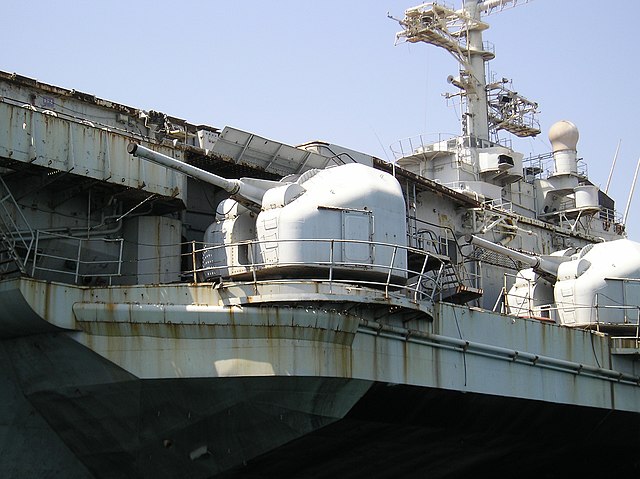
100 mm M68 on Foch after decommission
First generation M53. 55 cal., firing a 100 x 700mmR HR fuse shell. In brief:
- Elevation: 29°/s
- Traverse: 40°/s
- Rate of fire: 78 round/min
- Muzzle velocity: 870 m/s
- Effective firing range: 17,000 m (elevation 40°)
- Maximum practical range: 6,000 m aerial/12,000 m surface targets
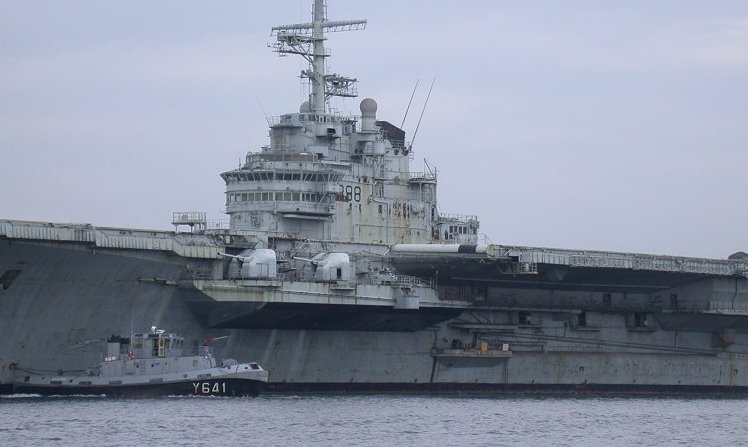
FS Clemenceau main guns turrets
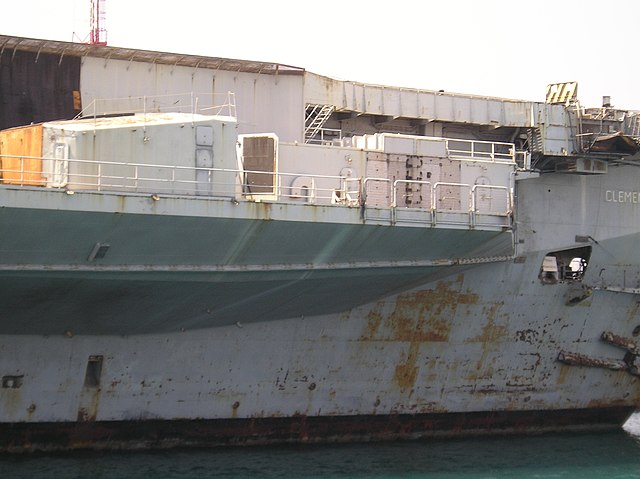
Stern sponsons details. FS Clemenceau waiting to be BU.
SACP Crotale EDIR systems (52 missiles)
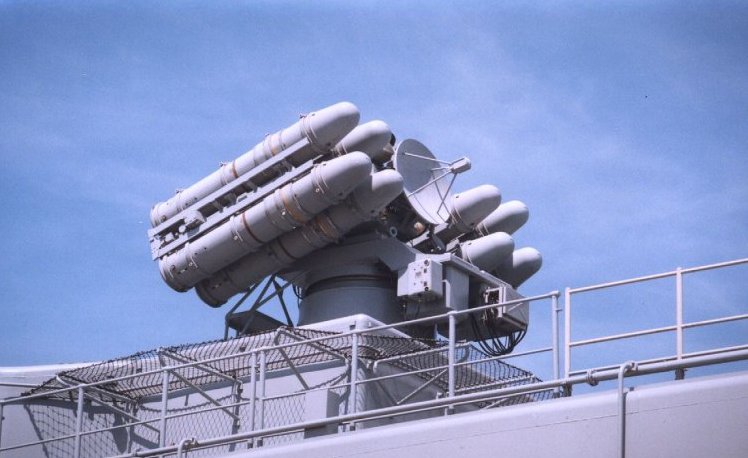
Crotale system (here on FS Tourville)
This system was installed during the 1980s refits on both carriers. The Crotale EDIR (Ecartométrie Différentielle Infrarouge) works with the radars DRBV 15 and DRBV 51B/C. Guidance rests on auto alignment and fuse detonation. Each system comprises three elements, the launch turret equiped with a Thomson Ku-band Target Pointer and 8 canisters. Under the turret launcher is the FCS comprising a radar data display and digital compruting system with display. The third part is the storage area, behind the deck and tailored for 18 spare missiles, with a lift for a full 30 minutes reload (all eight missiles). This is a derivative of the 1971 design Crotale R-440 in use in many armies. The Chinese PLAN also used its own derivative version on the Type 05212, Type 053H313 et Type 054A vessels.
Sadral SATCP systems
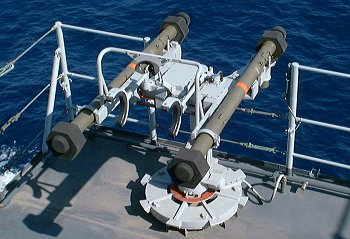
Installed in 1997. This system derived from the short SAM (barery larger than a MANPAD). This Mount comprises 6 Mistral missiles with an automatic fire control of the FCR or EO systems. They carried a 2.95 kgs payload to 930 m/sec or Mach 2.71 via infrared homing to any target in the vicinity of 6 km. Short range indeed. This system was merely adopted for the last refit of FS Foch destined to the Brazilian Navy, replacing the remaining 100 mm guns for and aft in combination with the Crotales.
Electronics
Both were equipped with the following systems over time:
-Radars DRBV-20C, DRBV-23B, DRBV-50, NRBA-50, CCA.
-Fire control radars: two DRBI-10, two DRBC 32A, two DRBC 31D
-SQS-503 sonar (fixed), removed in 1980
-ECM suite ARBR-16, ARBX-10
-Docoy launcher: 2x Syllex Rocket Launcher
-CCS: SENIT-1 Central Combat System
-Satnav: Syracuse, Fleetsatcom
Aviation Facilities
The landing area is 165.5 m (543 ft) long, 29.5 m (97 ft) wide angled at 8 degrees off of the ship’s axis. The flight deck was 265 m (869 ft) overall and its forward aircraft elevator was a side one, placed to starboard, as placed on US carriers, while the rear one was also placed the deck edge.
The ships had a single BS-5 steam catapult forward, both 52 m (171 ft) long at the bow, and a single BS-5 waist catapult on the angled landing deck. The hangar measured 152 m (499 ft) by 22 m (72 ft) fwd and 24 m (79 ft) aft, 7 m (23 ft) high, leaving plenty of room to spare for the parked aviation.
They also carried 1 800 m³ tons of jet fuel and 1100 liters (400 m³) of aviation gasoline (avgas) plus 3 000 m³ of ammunition for her air group alone. This was a far cry to the capacity onboard US supercarriers though and designed for shorter and less intensive deployments.
Air Group
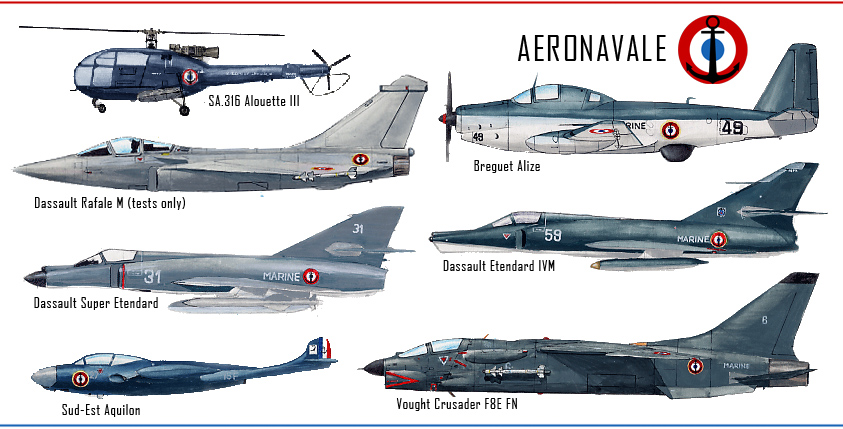
French Aeronavale, 1980s air group.
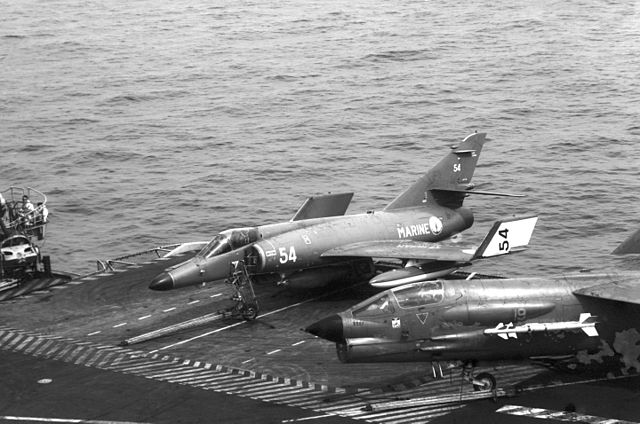
Super-Etendard and F-8 aboard Clemenceau
1950-60s: The first commissioned air group only comprised 40 aicraft, half that on US supercarriers of the time. The mark comprised SE.20 Aquilon 202/203 jets, Étendard IVM/P fighters and the Br.1050 Alizé ASW planes.
In 1967 Clémenceau had aboard six F-8E(FN) superiority fighters, 18 Étendard IVM attack aicraft and 8 Alizé ASW piston-power aircraft.
In 1977, she had ten F-8E(FN) Crusader fighters, still sixteen Étendard IVM and four Étendard IVP for reconnaissance, six Alizé ASW and an helicopter park of two Super Frelon heavy SAR and two light Alouette II SAR and liaison helicopters.
In 1983, FS Foch still carried her six F-8E(FN) crusader fighters, alonsgide fifteen Super Étendard and three Étendard IVP plus five Alizé and six Super Frelon helicopters.
Their last 1990s air group at the time of the Gulf war comprised ten F-8E(FN) fighters, sixteen Super Étendard, three Étendard IVP, seven Alizé and two Alouette III.
The Dassault Rafale was the designed replacement for the F8 Crusader, but development dragged on so much the F8 was kept until their decommission, despite modifications made to operate the Rafale M (“marine”).
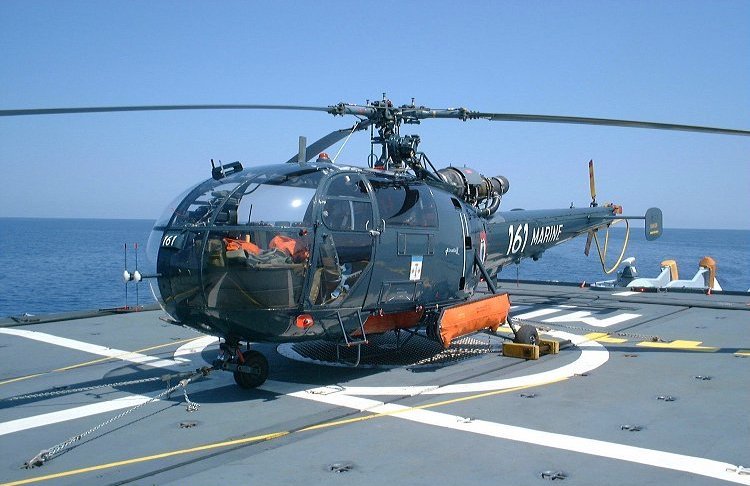
Alouette III used for SAR in the 1970s
PA 58 (Verdun class), the successor “atomic carrier”
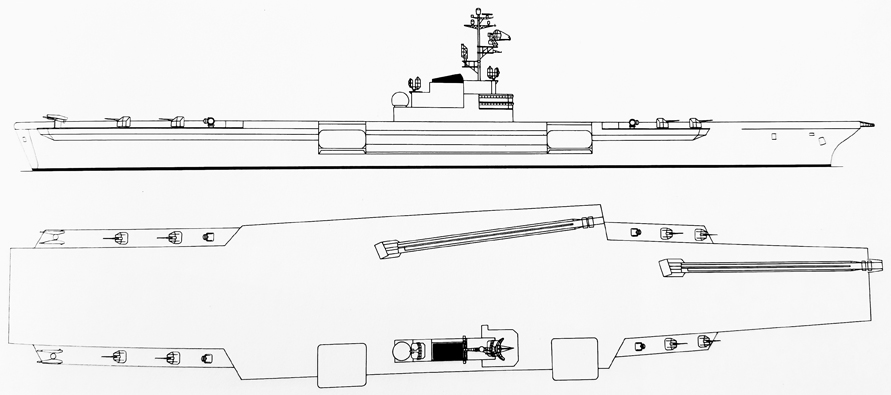
As soon as the Clemenceau class was approved, the admiralty planned its next class, much larger in order to operate large jets able to operate nuclear strikes. Known as PA58 it was advanced enough for the Navy to have named the lead ship FS Verdun. Much larger than the PA54 (Clemenceau) they reached 45,000 tons, twice as much as the PA54, looking at the first Super-carriers like the Forrestal class. The ship reached 286 m overall, and was 34 m wide for 58 m wide flight deck, much more than the Clemenceau. It was still much smaller than the US carriers and the air group, much reduced in comparison.
Despite it’s atomic strike capabilities, nuclear power in France was not advanced enough to fir the new carrier with a nuclear plant, and thus, Steam turbines on 4 shafts for 200,000 shp and 33 knots was the solution chosen. Parking size on deck was larger, aircraft handling improved, with two larger, heavy capacity (22 tonnes) lifts, two large catapults forward and the same angled deck as the PA54. Armament comprised from the start two Masurca SAM systems on side sponsons plus eight 100 mm guns fore and aft of the flight deck on sponsons. The SAMs were placed just like on the Kitty Hawk class.
The air group was a repeat of the Clemenceau class, but with the addition of a squadron of Mirage IVM navalized version of the French atomic bomber. The Mirage IVM weighted 20 tons and so required new lifts and catapults. The rest comprised a park of Alizé ASW aircraft and Etendard fighter-bombers plus SAR helicopters for a total of 50 aicraft. In 1960, the admiralty considered the many delays and budget issues with the project, and eventually downgraded it without the Masurca SAM. Considered this time irrelevant, the program was terminated in 1961.
The result of these studies was the adoption of a nuclear strike aboard Foch and Clemenceau, carrying the AN52 nuclear bomb, which was brough to the objective bu a Super-Etendard, despite its limited range. A brand new carrier, this time nuclear-powered was announced in 1980 with the PAN program. Delays accumulated as discussions of a partnearship with the Ryla Navy which had broadly simlar requirements, although on a conventional basis. In the end, the Charles De Gaulle (R91) diverged considerably from the joint French-British project and PAN 2 was cancelled in the post-cold war budget cuts.

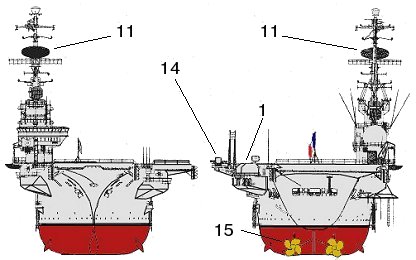

Infographics from wikimedia CC, Yannick Le Bris, from DCAN plans via Martine Destouches from Châtellerault archives.
⚙ Clemenceau’s 1961 Specs |
|
| Dimensions | 9,085 t, 11,100 t FL |
| Displacement | 180.5/187m x 20.3m x 6.5 m |
| Propulsion | 2 CEM Parsons geared steam turbines, 4 boilers, |
| Performances | 877,000 hp, 33 knots, range 4,000 nm |
| Armament | Eight twin 127 mm M1958 DP, ten twin 57 mm M1951 AA guns |
| Sensors | Radar DRBV 20A, DRBI 10 |
| Crew | 977 |
Clemenceau refits & modernizations
1966: Clemenceau had bulges fitted (like Foch).
1978: Lifts capacity increased to 20 tonnes and SENIT-1 CCS and SENIT-2 CCS installed
1986: Four 100mm/55 removed for 2×8 Crotale Navale SAM (36 R440) installed, as well as the radars DRBV-20C, DRBV-50, NRBA-50 and two Syllex decoy chaff launchers. The DRBV-15, and NRBA-51 radars were installed and Sagaie decoy RL, displacement rising to 27,307/32,780 tonnes.
1992: Two twin Simbad SAM (8 Mistral).
1997: Four 100mm/55 removed and 2×6 Sadral SAM (24 Mistral) installed and later two 30mm/82 OTO Breda-Mauser Model F for the Brazilian Navy.
Foch refits & modernizations
1966: Same as Clemenceau: Bulges added
1980: From July 15, 1980 to August 15, 1981, Foch had a major overhaul in Toulon: Internal quarters installations, living quarters, flight deck, propulsion system with 2 additional boilers, SENIT 2 satnav system and television network proving infos to all departments, inertial unit for Super-Etendard reclalibration, bunkers layout fit to house the AN 52 tactical nuclear weapon.
1987-88: From February 1987 to June 1988 Foch received two Crotale EDIR replacing the four aft turrets, and a DRBV 15 radar, 2 chaff EW Sagaie system and the Syracuse + Inmarsat satnav and transmission systems, modernized SENIT with links 11 and 14, CSEE DALLAS laser/IR camera landing assistance system, SNTI intercom, Minicin inertial navigation unit and ammunition bunkers fit to manage the ASMP cruise missile. The the fixed SQS-503 sonar was removed.
1993: Foch had some mofifications on the launching system to test the Dassault Rafale Marine, taking place in April 19-20 this year. For better NATO operability she was also fitted with the US Fleetsatcom transmission system, 2 OE-82 antennas and the AIDCOMER system.
1995-97: From September 1995 to September 1997 she had her last radical upgrade before being resold to Brazil: The while propulsion system was modernized; New boilers and control systems, and two Sadral SATCP systems installed to replace last turrets forward and aft port and starboard plus the latest SENIT 8/01 (SARA) combat system.
✚ Read More/Src

Shipbucket rendtition by Vossieln via seaforces.org
Links:
⤤ On seaforces.org
⤤ Short construction video footage in US news of the time
⤤ On laststandonzombieisland.com
⤤ Comparison with HMS Audacious
⤤ On hazegray.org
⤤ On militaryfactory.com
⤤ naval-technology.com
⤤ wiki
⤤ ffaa.net
⤤ netmarine.net
⤤ Navypedia
⤤ On netmarine.net
⤤ globalsecurity.org
⤤ alabordache.fr
⤤ 100 mm gun on netmarine.net
⤤ The 100mm on navweaps.com
⤤ On bbc news 2009
⤤ On navaltoday.com
⤤ Kagero Book/topdrawings
Books:
❏ John Gardiner Conway’s all the world’s fighting ships 1947-1995 (1978, reedition 1990)
❏ Boniface, Patrick (September 2015), “Clemenceau carriers”, Ships Monthly: 46–49
❏ War Machines Encyclopedia, Aerospace Publishing Ltd, London, 1984, p.476
Plans: ArromanchesLafayetteDixmudeJoffreBearnFoch
The models corner:

1:400 Foch Heller’s starter kit. The company also proposes a full 3-ship pack sea supply including Clemenceau/Foch, a Durance class tanker and Dupetit-Thouras class Frigate. Or FS Charles de Gaulle.
The famous 1:400 Heller Kit (likely out of stock). It was also poposed by HP-Models at 1:700, Progresswerk Nürnberg 1:400, Shizukyo (SK) 1:1000, Blue Ribbon Collectors Series, but also Heller, Lodela and ADA XIEDA at 1:1750 for wargaming.Query
 FS Clemenceau (1957)
FS Clemenceau (1957)
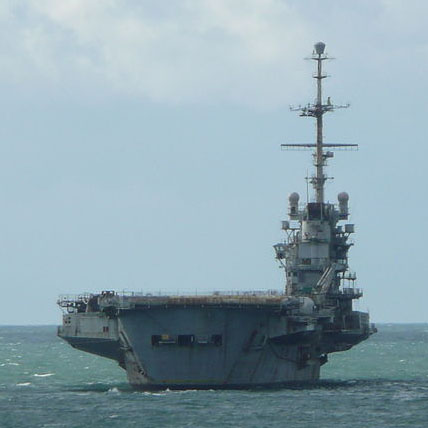
The construction start date dates from May 26, 1954 and the assembly of the first prefabricated elements (at the Brest arsenal) began in December 1955 at basin no. 9 in Laninon (DCAN). Launched on December 21, 1957, the Clemenceau carried out its first sea trials on November 23, 1959. Admitted to active service on November 22, 1961 and assigned to the aircraft carrier group (ALPA), she immediately sailed for Toulon where it will be based initially.
From January 29, 1962, she participated until February 5 in the BigGame NATO exercise, with the US Sixth Fleet (USS Saratoga and USS Intrepid aircraft carriers), in the Western Mediterranean, as an anti-aircraft carrier. submarine, then he continues, from March 9 to April 2 with the NATO exercise Dawn Breeze VII, in the Gibraltar area.


Ckemenceau’s deck between Upgrades, in 1970 and 1990
During her long career, Clemenceau took part in the majority of French naval operations:
- 1968: deployment of Force Alfa in the Pacific;
- 1974-1977: operations Saphir I and II in the Indian Ocean for engagement and protection during the independence of the Republic of Djibouti;
- 1983-1984: Operation Olifant in the eastern Mediterranean during the Lebanese civil war;
- 1987-1988: Operation Prometheus in the Arabian Sea during the war between Iran and Iraq;
- 1990: Operation Salamander in the Red Sea and Arabian Sea during the conflict between Iraq and Kuwait;
- 1993-1996: Operation Osprey then Salamander in the Adriatic Sea during the Yugoslav civil war.
Between 1959 and 1997, FS Clemenceau underwent like Foch numerous modifications, among which the the “Crusader Capability” in 1966, “nuclear qualification” on December 10, 1978 with five AN-52 bombs and medium-range ASMP cruise misiles from 1993, 2 “Crotale” EDIR systems in 1985, modernization of its propulsion and detection system. In 1960s and 1970s, the two aircraft carriers were often moored side by side at the “aircraft carrier berth” in Brest’s harbor.
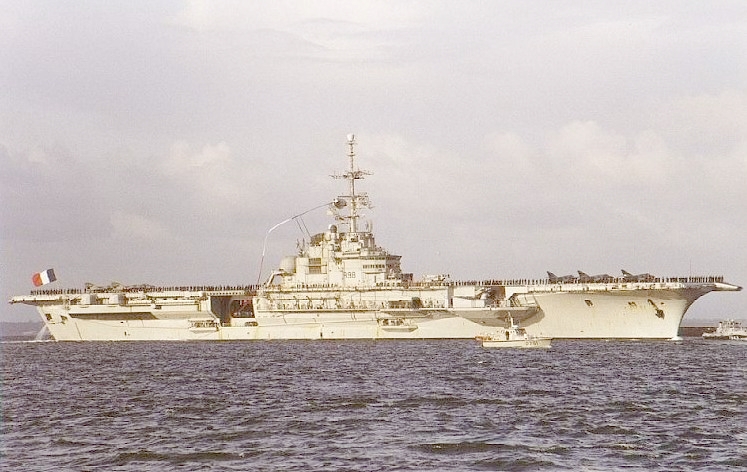
She sailed on all oceans and seas of the world. At the end of her career, she cumulated one million nautical miles, 48 times around the globe, having spent 3,125 days at sea, with 80,000 hours of air operation, more than 70,000 catapult launches.
In 1983, she also disrupted a long tradition as the first Marine Nationale seagoing vessel to greet female personnel on board. The three women were an Army doctor, senior master military secretary and first quartermaster. Of course this will change on the long run and peak to around 20% recently.
Faithful to another long-held tradition of Marine Nationale, while anchored in Toulon, she welcomed on board many painter artists like Maurice Boitel, Gaston Sébire (official painter of the Navy) and others. Her Junior Officers’ Wardroom was decorated with an oil on canvas by naval painter Mathurin Méheut. Filmmaker Pierre Schoendoerffer, which immortalized the French Indochina war, and was himself a navy veteran, also sailed on board in 1981, from Brest to Hamburg.
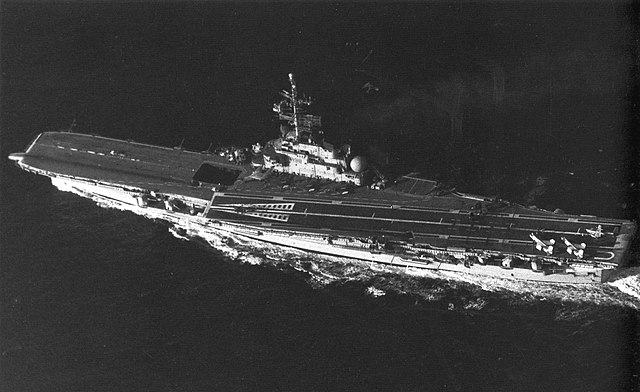
Clemenceau, overhead view, in 1981
Throughout her lengthy career, the “clem” as she was popularly known by her crew and the French public at large, participated almost all major French naval operations. From 12 January to 5 February 1962, her firdt test was NATO exercise BigGame with the US 6th Fleet, in the western Mediterranean. There she acted as ASW aircraft carrier. From 9 March to 2 Aprilshe took part in NATO’s Dawn Breeze VII, in the Gibraltar zone.
-From January 1968, Clemenceau took part in the large research for the recently disappeared submarine Minerve, in the Mediterranean. Contact was lost just 25 nautical miles from Toulon, her home port. On 22 July 2019 French Defence Minister Florence Parly announced her wreck had been discovered, and causes of her loss now more clear. That was also a great relief for the crew’s relatives, so many yeasr after the event. Minerve’s wreck is now a grave site.
-Also in 1968, Clemenceau was deployed for the first time to the south Pacific. She assisted to preparation and detonation in French Polynesia of Canopus, first French hydrogen bomb. As the centerpiece of Alfa Force she assumed the defence of two atolls where at that time was assembled more than 40% of the entire French navy in tonnage. Clemenceau as flagship directed forty ships. This was at the time also one of the largest fleet in the pacific, outside the US 7th fleet and JSDMF. However at the time, De Gaulle decided to keep France out of NATO and she no longer took part in joint exercizes.
-In 1974–1977, Clemenceau was deployed off the African coast and Indian Ocean. She took part in Operation Saphir I and Saphir II to defend the recently obtained concession of Djibouti, transformed into a naval base.
-In 1983–84 saw her deployed off the Lebanese coast during the Civil War, rotating with Foch and providing constant air support to French peacekeepers operating within the Multinational Force in Lebanon and the United Nations Interim Force (UNIFIL) in what was called Operation Olifant.
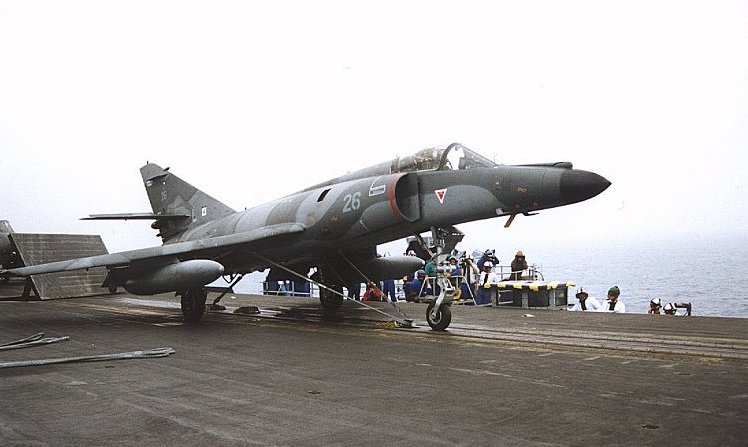
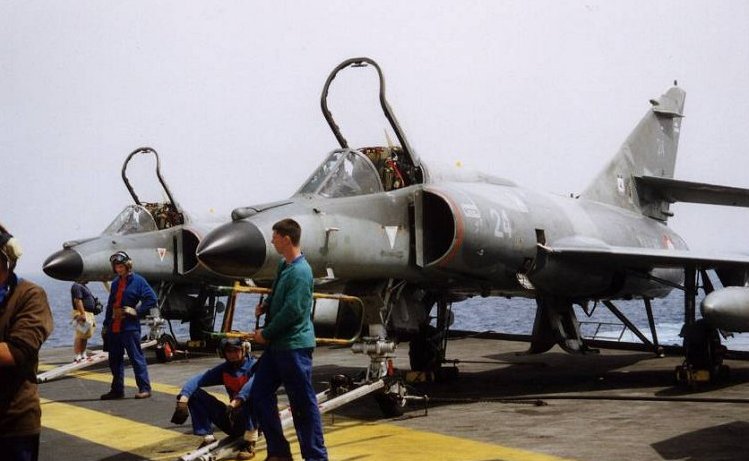
Super-Etendards launched from FS Clemenceau in 1980s operations.
-In 1987–1988 she took part in Operation Prométhée in the Gulf of Oman, as observer and to protect trade in the red sea during the Iran-Iraq war. The Promethée battle force, called Task Force 623, centered around Clemenceau, also comprised the mine counter-measures support ship Loire, the fleet tankers Meuse, Var, and Marne.
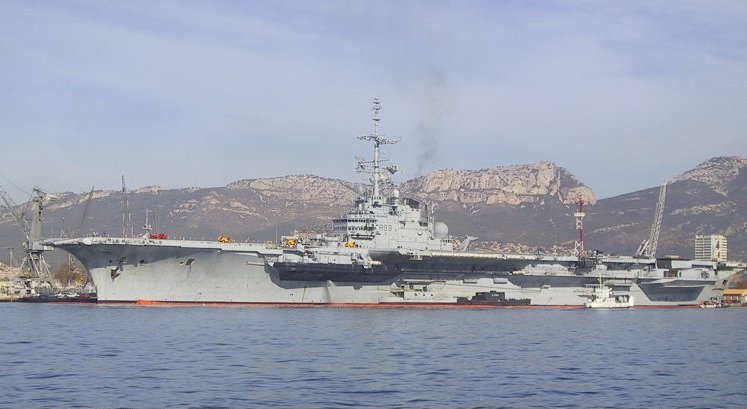

-In 1990, she took part in Operations Desert Shield & Operation Desert Storm. Under escort of the missile cruiser Colbert and the tanker Var, she carried 40 army antitank helicopters SA-341F/342 Gazelle and transport SA-330 Pumas, plus trucks. The French side of the 1991 campaign was called Operation Salamandre in the Red and Arabian Seas until the liberation of Kuwait.
-In 1993-1996 Clemenceau experienced three tours of duty off the former Yugoslavia: Operation Balbuzard in support the UN troops. She also later took part in Operation Salamandre in the Adriatic Sea. Her later years were less impressive and she remained mostly in the Mediterranean for her last sorties in between maintenance rounds, which proved more difficult as time passed.
Disposal
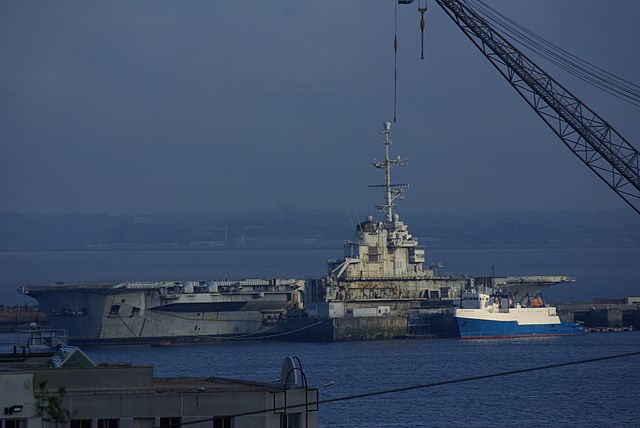
In Brest, 2008, before being transferred to UK for scrapping.
On 31 December 2005, Clemenceau left Toulon and sailed to Alang in India to be BU, despite ecologist protests about improper disposal. On 6 January 2006, the Supreme Court of India denied access to Alang and the ship was boarded by activists held by Egyptian authorities when transiting the Suez Canal. Eventually the French Conseil d’État ordered Clemenceau back to France, and the British Graythorp yard near Hartlepool was tasked to scrap her in far better conditions. It started on 18 November 2009 and ended in late 2010.
 FS Foch (1959)
FS Foch (1959)

F-14 Tomcats from USS JF Kennedy above FS Foch during a joint exercises in 1990.
In brief
- In 1966, Foch took part in Force Alfa, in the Pacific French nuclear experiments. She was relieved by FS Clemenceau.
- In 1977 she was in the Red Sea to relieve Clemenceau, to protect the independence of Djibouti (Operation Saphir II).
- In 1978 she was redeployed in the Red Sea, always for Operation Saphir II.
- In 1983, she took part in supporting the French contingent deployed in Lebanon (Operation Olifant), rotating with Clemenceau and providing constant air support to French peacekeepers in coordination with UNIFIL.
- From 1993 to 1999, she took part in Operations Balbuzard, Salamandre and Trident (Osprey, Salamander, Trident) in the Adriatic. It was part of the deployment off former Yugoslavia in coordination with UNPROFOR, SFOR, and KFOR. Foch was tasked of the close protection of French elements in thes eoperations, and carrying out air strikes when directed by UN and NATO HQ.
In 1992 for the first time she deployed the Dassault Rafale for its first tests, after deck modifications made in preparation to and operate it. These tests went on in 1995-96 after further deck modifications.
Combat history
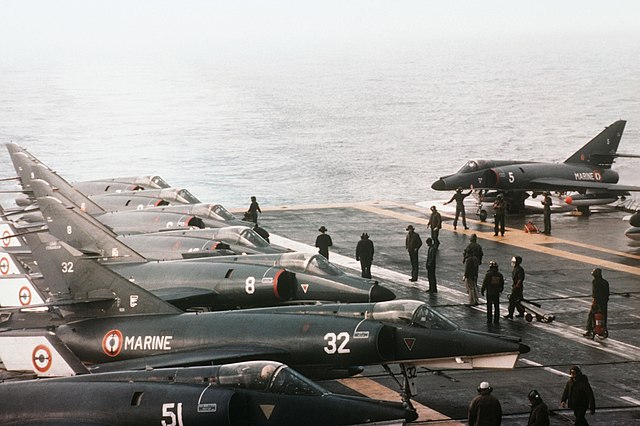
Etendard IVM and Super-Etendard aboard FS Foch in 1983
Her “near-duel” in which her French F-8 Crusaders had a serious confrontation was On 7 May 1977: Two Crusaders on patrol were interecepting for an exercizes French Air Force (4/11 Jura squadron) F-100 Super Sabres stationed at Djibouti. The flight leader initiated a dogfight but quickly called his wingman for help as it happened these were not the expected French jets but two Yemeni MiG-21 Fishbeds. Master armament was switched to “on” but, but after a few passes, all four fighters wisely disengaged.
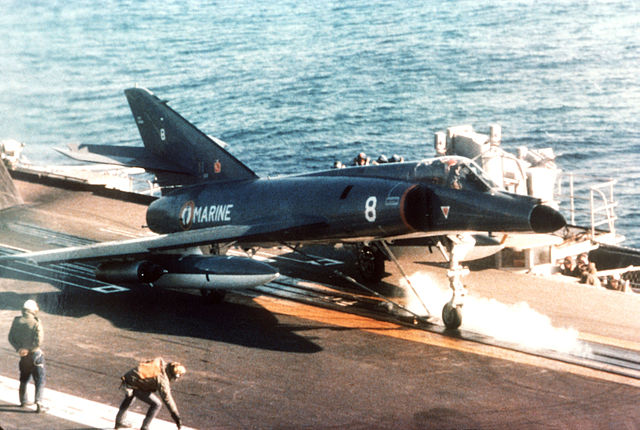
Super Etendards launched from Foch off Lebanon, 1983
In October 1984, Foch took part in Operation Mirmillon off the coast of Libya due to the Gulf of Sidra crisis (International waters claimed by Libyan leader Khaddafi). She flew many sorties, spotted Lybian jets but unlike US Navy’s F-14s, never was closed enough to engage Libyan jets, most of which were Mig-21 and 23.
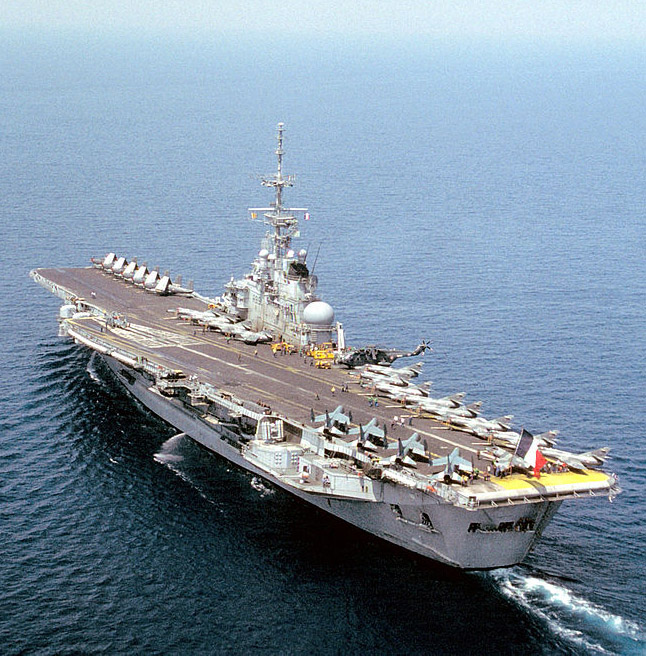
Operation Dragon Hammer, 1992
During the Yugoslav Wars in the summer of 1993, winter of 1994, and summer 1994 she was in close support of UN operations, deploying her F-8 Crusaders to encfoce the no fly zone, and Super Étendards. Later in 1998 she deployed the same super-etendards for close strike missions over Serbia in 1999. She lost no planes, despite two SAM being launched one day. However she had to be withdrawed earlier than expected after four continuous months, longest yet, in part due to problems with her catapult system.
Globalscurity.org and sadly other sites reports also a mutiny in 1999 as cause for her departure. It indeed happened, but its story was amplified by a disgruntled former (Ret.) officer, which faslely reported to the press at the time that 60 volunteers of Maghrebi descent took the captain hostage in the cafeteria to protest against French raids on several sites in Kosovo, considered holy for the Muslim.
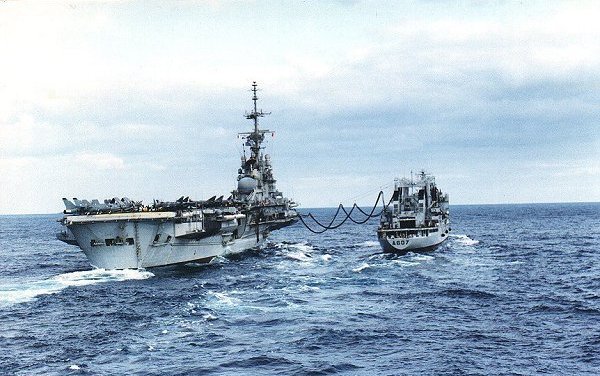
Replenishment at sea (RAS), called in french RAM (RavitAillement en Mer)
This had been debunked since in Cols Bleus Magazine, the official navy review. Instead of the alleged commando operation, a few gendarmes solved the issue, and six sailors (not of Maghrebi decent) only were ousted of the ship because of their conduct, and repatriated to Hyères NAS. There was indeed general discontent of some recently enlisted young recruits after a four-month non-stop deployment with only two short stops in Trieste, during Operation Trident. Sadly this fake new is still found on some websites.
In 2000, Foch made her last deployment. She led Task Force 473 on a four month around-the-world tour. In fiction she appeared in the 1995 film “Crimson Tide” with American journalist Richard Valeriani playing himself aboard reporting. Foch also appears in Tom Clancy’s 1986 novel “Red Storm Rising”.
As São Paulo
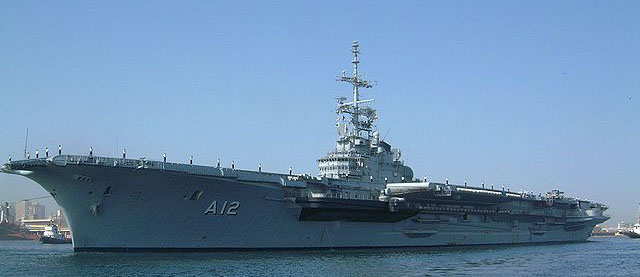
Foch was in disposal until September 2000, afetr negociations with the Brazilian government, interested in acquiring her. She was purchased eventually for US$30 million with no air group and recent Mistral SAM additions. She was to replaced the WW2 Minas Gerais after 40 years of service. Previouslt Bazil also approached Spain for a new built US$500 million or acquiring Dédalo. 23 second-market upgraded AF-1 (A4 Skyhawk) fighter were purchased from Kuwait for $70 million, combined with existing Brazilian helicopters were intended for the São Paulo air group.
Purchased while still operational, she was received in her current state by the Brazilian Navy and incorporated, commissioned on 15 November 2000. Next she trained with her AF-1 fighter group for qualificatitions and was visited while in Rio de Janeiro on 17 February 2001.
Given her age and despite her last upgrades, the new carrier (same pennant R99), had a short active life. She took part in Operations ARAEX, PASSEX, and TEMPEREX, to qualify and train the Argentine Navy’s Super Étendards and S-2T Turbo Trackers. She also practice carrier-based attack missions. In 2005 she was struck by a major fire, started by an explosion killing one and injured ten, due to a rupture in the steam pipeline. The Brazilian Navy newt launched an extensive overhaul.
When completed in late 2009, she had all steam turbines repaired and cleaned, maintenance of the surface condensers, all boilers retubed, high-pressure compressors fixed, AC electrical generator refurbished, spare parts purchased and new pumps, valves and piping network replaced. Sghe received two new API oil-water separators, two water cooling units, new chemical oxygen generator, new oil tanks, new Naval Tactical Data System, closed-circuit television system, IFF transponder, MAGE system (ESM), new flight deck inspection facilities and new Optical Landing System processing unit and complete overhaul of the aircraft catapults.
Her 12 A-4 Skyhawks were upgraded by Embraer for $140 million as the AMX and F-5EM. They gained the new Elta 2032 radar and carried the MAA-1B, Python 4, and Derby AAMS. Marsh Aviation converted her four S-2T Turbo Trackers to AEW planes to be later delivered. This was added to six S-70B Seahawk helicopters purchased in 2008. However even so after her recommissioning in 2010, her service life was cut short. São Paulo suffered another major fire in 2012 and by September 2016 repairs were still going on when the commander of the Brazilian Navy, Admiral Eduardo Leal Ferreira announced a radical overhault of her old propulsion systemand replacement of catapults. But it was never done as of 14 February 2017, she was announced decommissioned due to budget constraints. It was formal on 22 November 2018 and since 2020, there is an ongoing French effort to turn her into a museum back in France.
Last user of “Le Crouze”

F8E (FN) of Flotilla 14F, landivisio, June 1985 in its original livery
When facing the construction and planned completion of its two large aicraft carriers (about Essex-size) to replace natably the smaller Arromanches, oppoortunity arose in 1962 to consider the acquisition of something better than the current SE. Aquilon (French-built de Havilland Sea Venom), but only had Dassault’s Etendard IV, a small multirole naval attack plane, not able to take on first rate interceptors of the time. Without an easy way to convert the Mirage III into a naval fighter, as it was never maent to be, one quick solution was to turn to the US and it’s ever growing menagerie of naval aircraft. In 1962 there was no contest at the best: The Vought F8 Crusader, the “last gunsliger” made it’s entry debut in the USN and was quite promising as interceptor, even breaking all records of USAAF models of the time.
The French Navy was especially interested into its main asset, an innovative variable-incidence wing provided with high-lift slats, flaps and drooping ailerons allowing such a low-speed lift that despite it’s huge size, the new interceptor can operate from the fleet of SBC-34 Essex carriers, safely. The French looked at the similarities to their requirements and don’t look further for its adoption, starting negociations with the Pentagon for their acquisition. However they realized the Clemenceau were still smaller and the bird needed to be further tamed if possible, to what Vought answered with having the angle of incidence of the wing going from 5 to 7°, enabling a 12 knots drop in landing speed, which was quite welcome.
Henceforth, the French gocernment announced in 1962 the purchase of 40 F-8E(FN), plus six TF-8E(FN) for training. In all, 42 single-seaters were ordered, to be placed into two Flotilla in France, the 12F and 14F based in landivisiau, Britanny. The first F-8E(FN) flew on June 26, 1964 while Pilots trained in VF-174 “Hell’s Razors” at NAS Cecil Field, Florida.
The new warbird was outright loved by the French for its capabilities and nicknamed “Le Crouze”.
With these, both Clemenceau and Foch would have a first rate interceptor for many decades. Perhaps too much. Indeed in the early 1980s was asked the question of their replacement, despite a proposal for a serie of possible upgrades. They were planned to be replaced by the Dassault Rafale, but the latter was still in nigociations with other partner countries, which eventually created the European 4th gen. fighter split precisely due to differences of views concerning the CATOBAR carrier constraints specific of the French (leading to the Eurofighter Typhoon). Delays had the Rafale only first flying on July 4, 1986, and the Rafale M for “Marine”, only were operational from December 2000.
This meant all this time, “Le Crouze” had to make due for first rate interception.

F8E (FN) modernized in 1986 with its new livery, Flotilla 12F.
As planned, an answer was provided: Dassault introduced in 1978 already the “Super Etendard” to replace the Etendard IV and provide some well-needed modern electronics and capabilities, but only with a secondary air defence role due to its speed of only 1 560 km/h (Mach 1,3). The second measure was the modernization of the F-8E(FN) Crusader:
It was first upgraded to carry four pylons for US Sidewinder missiles, replaced by the more modern Matra R530 missile, until withdrawn from service in late 1989 and the Magic 2 therafter. But also they received the new improved airframe of the F-8J in the early 1970s, and by the late 1980s they were given the following improvements as a life-extending measure:
-New zero-zero capable Martin-Baker Mk. 7 ejection seat.
-New wiring and hydraulic system
-Cockpit instruments rearranged and modernized.
-New avionics fitted (radar altimeter, IFF, ILS, VOR)
-Mirage F1 gyroscopic navigation system adopted.
-Thomson-CSF SHERLOC radar warning receiver.
The first of these was completed and tested by June of 1992. By September 1994, 12 were delivered, now known as the “F-8P” (For Prolongé/Prolonged). Sea trials took place in 1993. This was the penultimate version of the venerable Crusader, started in the 1950s as a pure gun interceptor. The last operational ones, No.7, 10, 11, 34, 39 were retired on December 15, 1999 at NAS Landivisiau, after a 40+ years service…

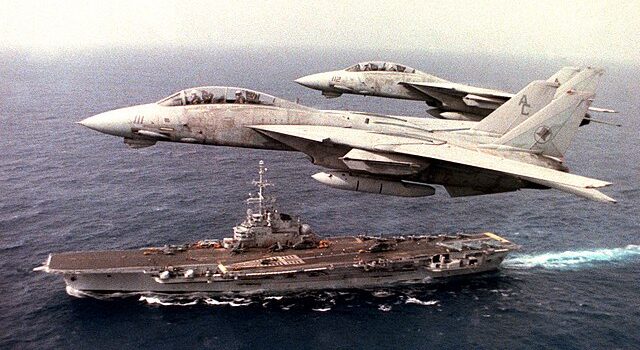
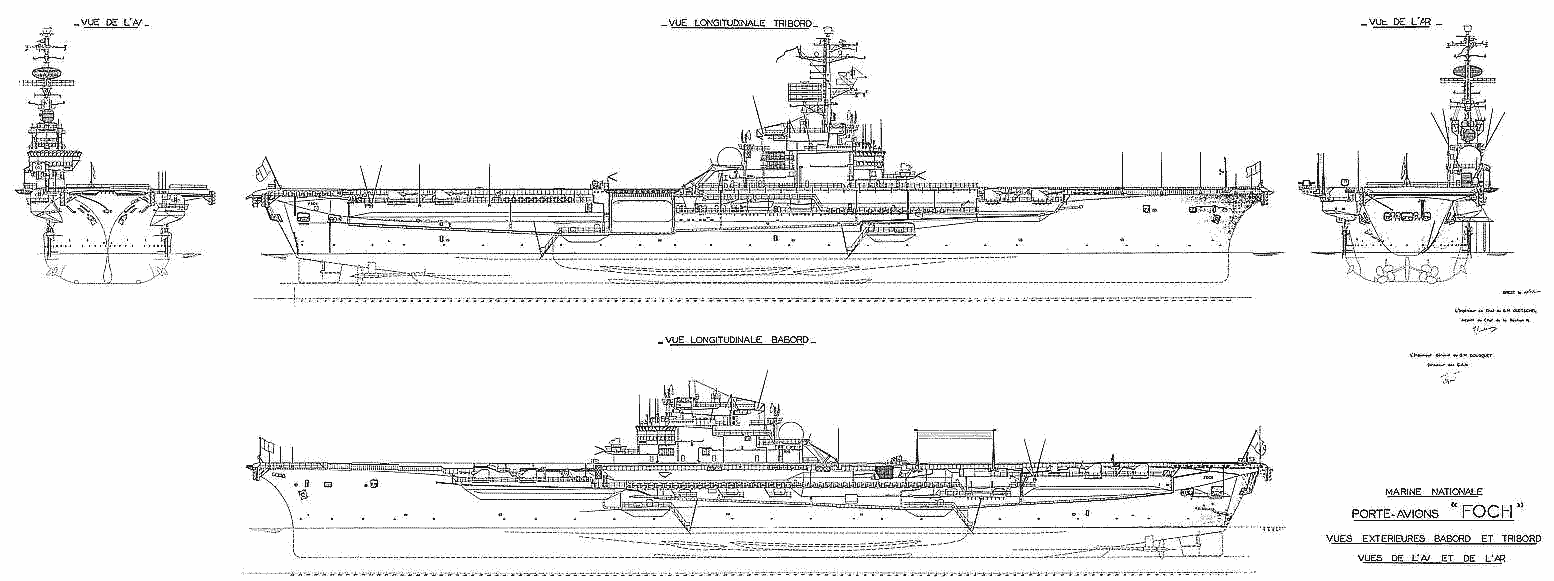



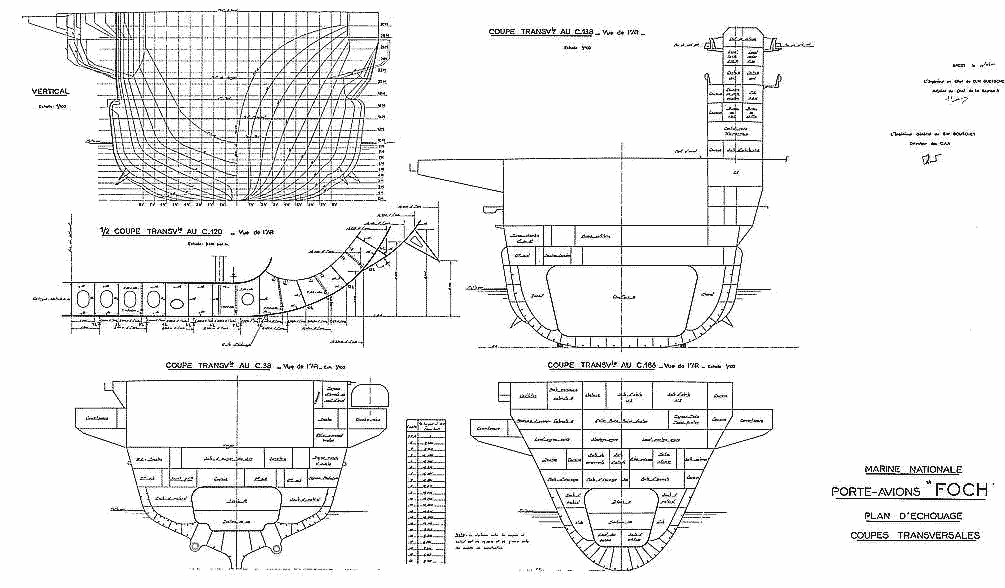
















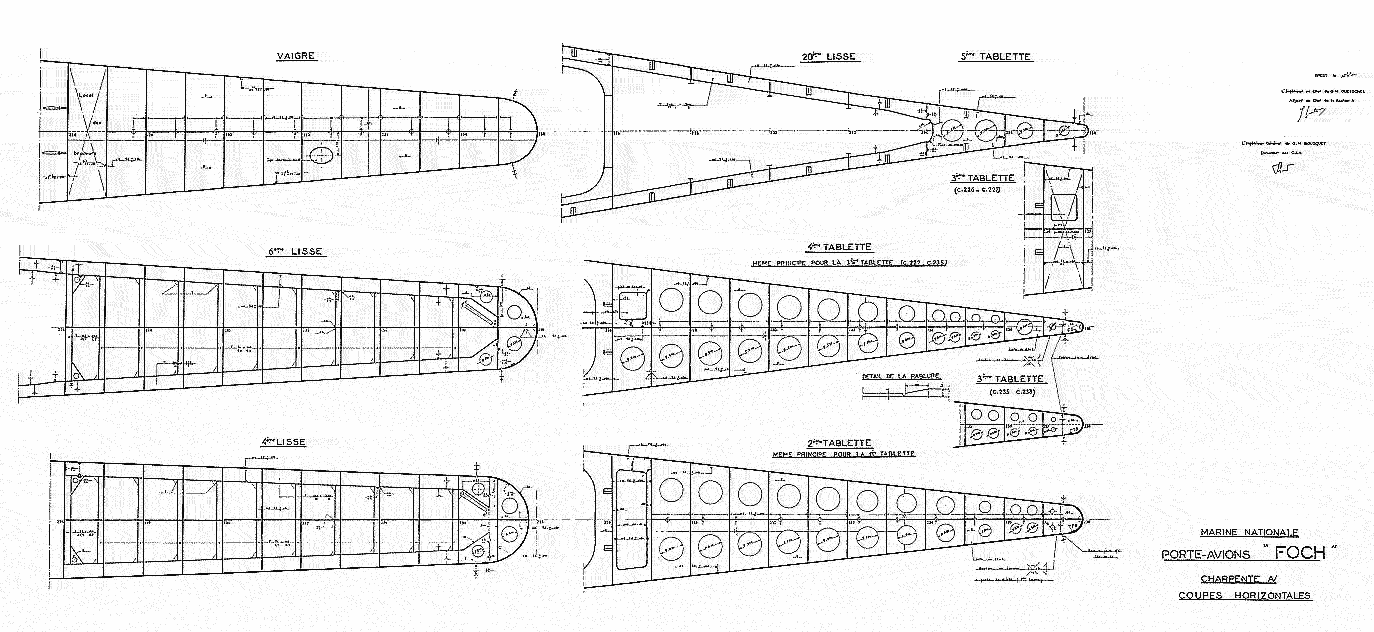


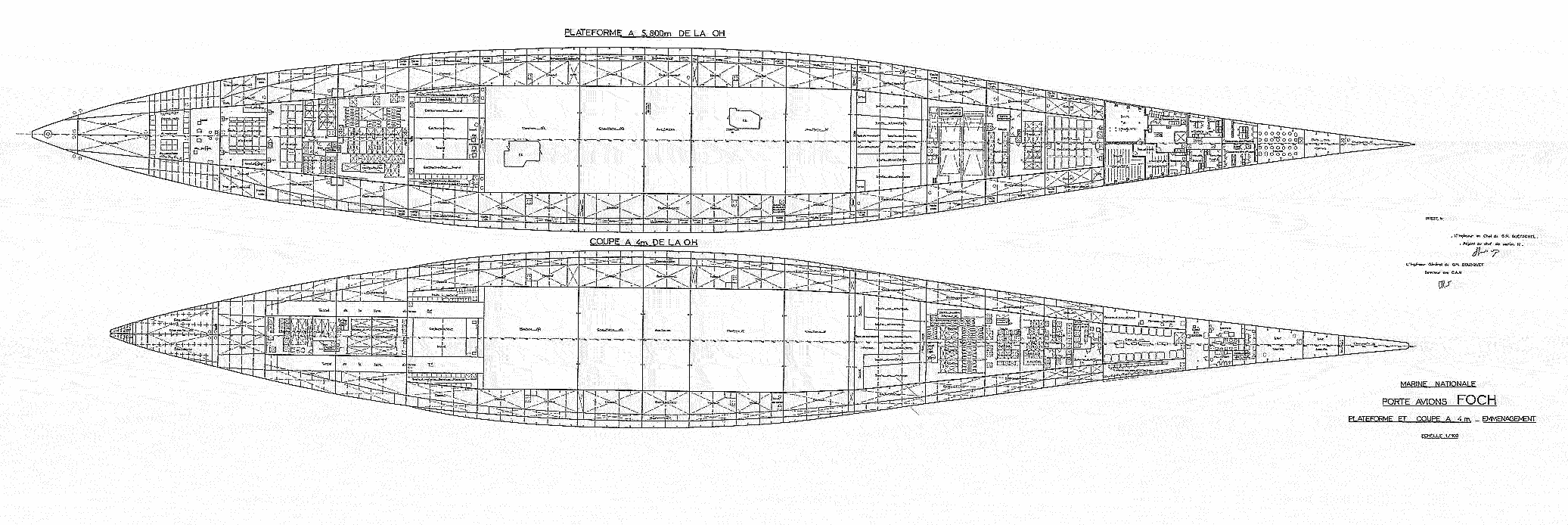
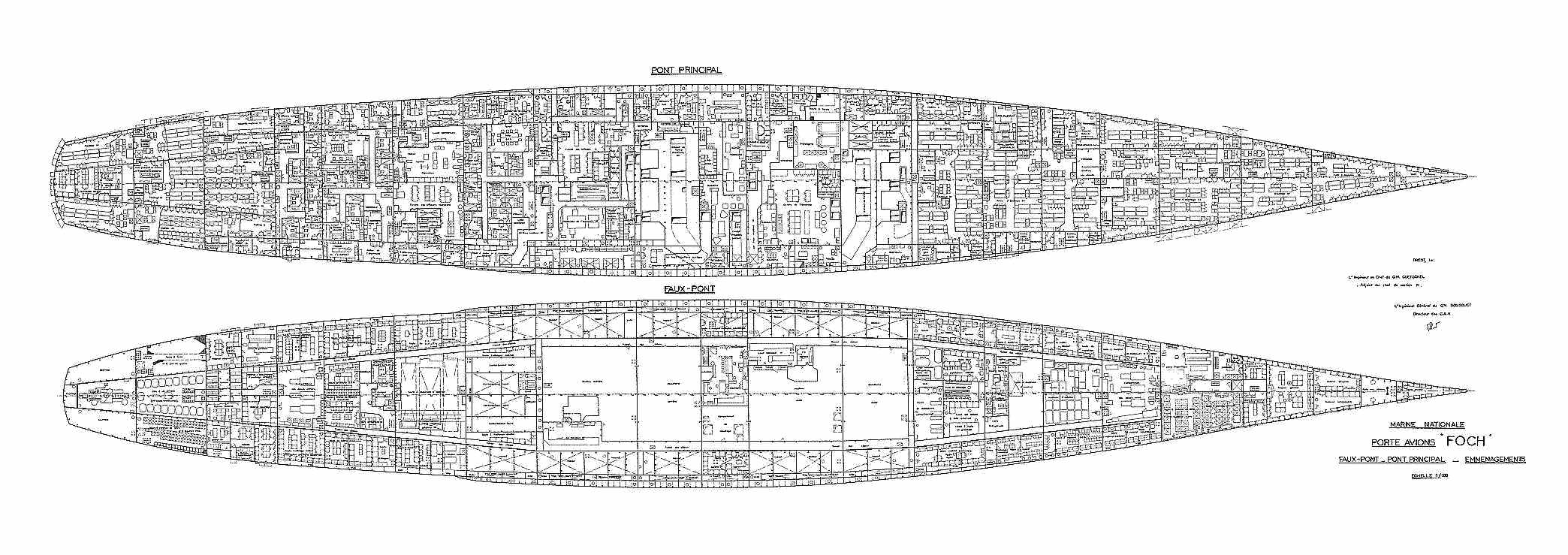



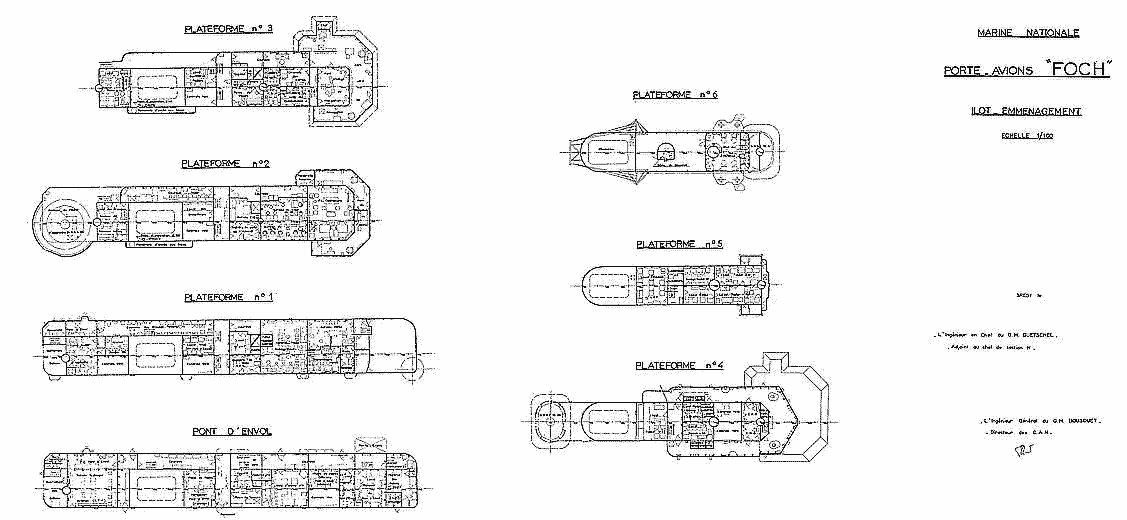
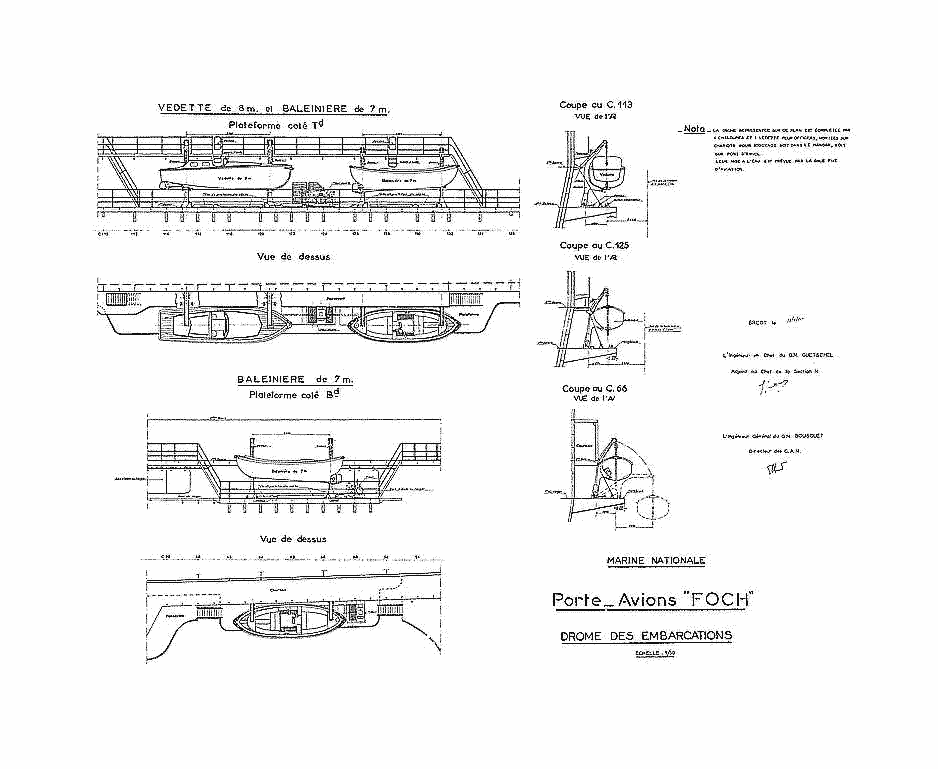
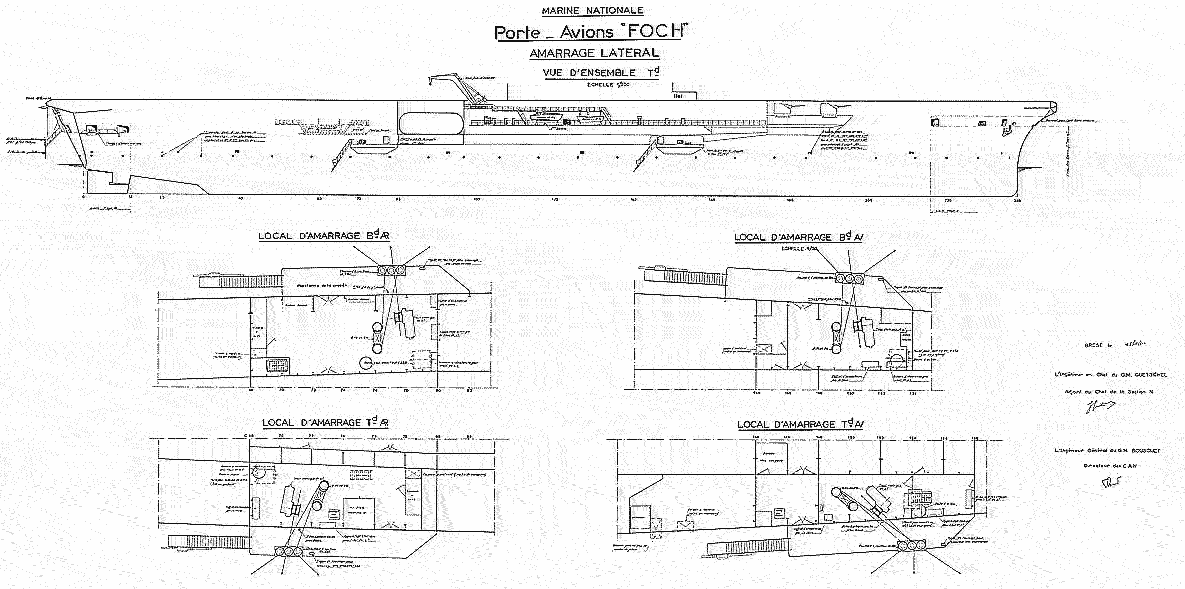
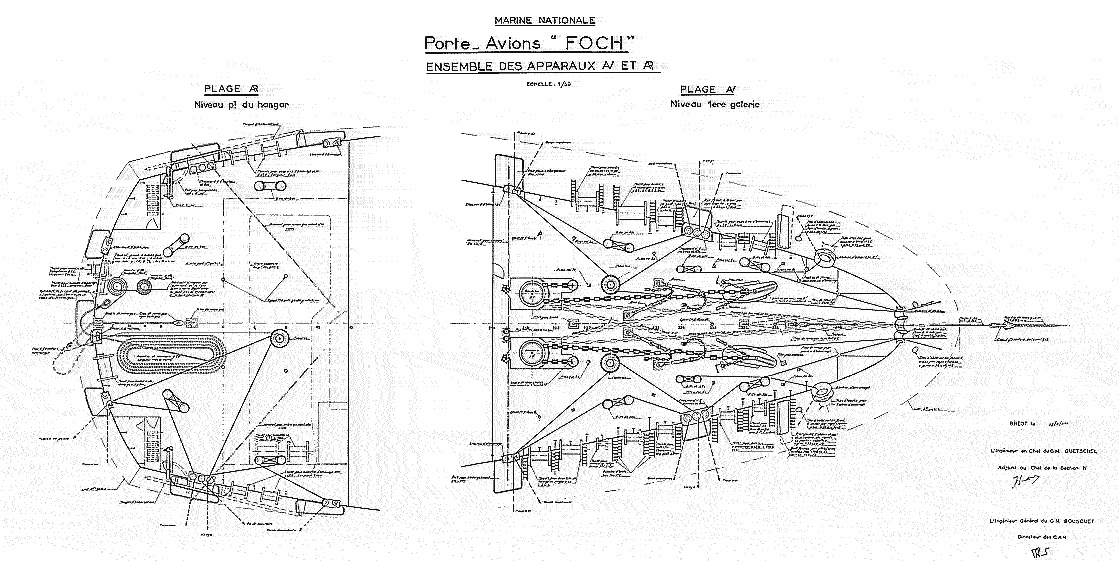
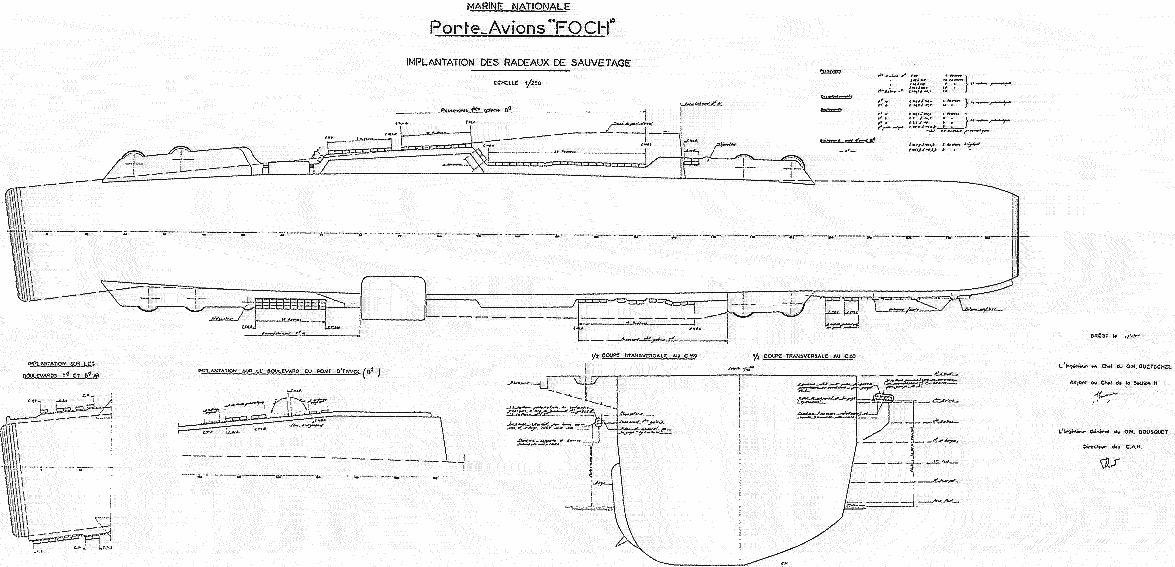


 Latest Facebook Entry -
Latest Facebook Entry -  X(Tweeter) Naval Encyclopedia's deck archive
X(Tweeter) Naval Encyclopedia's deck archive Instagram (@navalencyc)
Instagram (@navalencyc)





 French Navy
French Navy Royal Navy
Royal Navy Russian Navy
Russian Navy Armada Espanola
Armada Espanola Austrian Navy
Austrian Navy K.u.K. Kriegsmarine
K.u.K. Kriegsmarine Dansk Marine
Dansk Marine Nautiko Hellenon
Nautiko Hellenon Koninklije Marine 1870
Koninklije Marine 1870 Marinha do Brasil
Marinha do Brasil Osmanlı Donanması
Osmanlı Donanması Marina Do Peru
Marina Do Peru Marinha do Portugal
Marinha do Portugal Regia Marina 1870
Regia Marina 1870 Nihhon Kaigun 1870
Nihhon Kaigun 1870 Preußische Marine 1870
Preußische Marine 1870 Russkiy Flot 1870
Russkiy Flot 1870 Svenska marinen
Svenska marinen Søværnet
Søværnet Union Navy
Union Navy Confederate Navy
Confederate Navy Armada de Argentina
Armada de Argentina Imperial Chinese Navy
Imperial Chinese Navy Marinha do Portugal
Marinha do Portugal Mexico
Mexico Kaiserliche Marine
Kaiserliche Marine 1898 US Navy
1898 US Navy Sovietskiy Flot
Sovietskiy Flot Royal Canadian Navy
Royal Canadian Navy Royal Australian Navy
Royal Australian Navy RNZN Fleet
RNZN Fleet Chinese Navy 1937
Chinese Navy 1937 Kriegsmarine
Kriegsmarine Chilean Navy
Chilean Navy Danish Navy
Danish Navy Finnish Navy
Finnish Navy Hellenic Navy
Hellenic Navy Polish Navy
Polish Navy Romanian Navy
Romanian Navy Turkish Navy
Turkish Navy Royal Yugoslav Navy
Royal Yugoslav Navy Royal Thai Navy
Royal Thai Navy Minor Navies
Minor Navies Albania
Albania Austria
Austria Belgium
Belgium Columbia
Columbia Costa Rica
Costa Rica Cuba
Cuba Czechoslovakia
Czechoslovakia Dominican Republic
Dominican Republic Haiti
Haiti Hungary
Hungary Honduras
Honduras Estonia
Estonia Iceland
Iceland Eire
Eire Equador
Equador Iran
Iran Iraq
Iraq Latvia
Latvia Liberia
Liberia Lithuania
Lithuania Mandchukuo
Mandchukuo Morocco
Morocco Nicaragua
Nicaragua Persia
Persia San Salvador
San Salvador Sarawak
Sarawak Uruguay
Uruguay Venezuela
Venezuela Zanzibar
Zanzibar Warsaw Pact Navies
Warsaw Pact Navies Bulgaria
Bulgaria Hungary
Hungary

 Bundesmarine
Bundesmarine Dutch Navy
Dutch Navy Hellenic Navy
Hellenic Navy Marina Militare
Marina Militare Yugoslav Navy
Yugoslav Navy Chinese Navy
Chinese Navy Indian Navy
Indian Navy Indonesian Navy
Indonesian Navy JMSDF
JMSDF North Korean Navy
North Korean Navy Pakistani Navy
Pakistani Navy Philippines Navy
Philippines Navy ROKN
ROKN Rep. of Singapore Navy
Rep. of Singapore Navy Taiwanese Navy
Taiwanese Navy IDF Navy
IDF Navy Saudi Navy
Saudi Navy Royal New Zealand Navy
Royal New Zealand Navy Egyptian Navy
Egyptian Navy South African Navy
South African Navy






























 Ukrainian Navy
Ukrainian Navy dbodesign
dbodesign